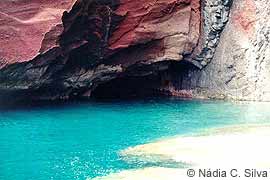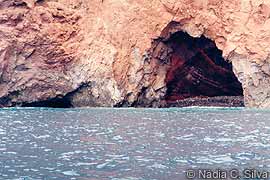THE HABITAT OF THE ENDANGERED MEDITERRANEAN MONK SEAL (MONACHUS MONACHUS) IN THE ARCHIPELAGO OF MADEIRA
Alexandros A. Karamanlidis1, Rosa Pires1, 2, Nádia C. Silva2 and Henrique C. Neves2
1) Department of Biological Sciences, Manchester Metropolitan University, Manchester M1 5GD, UK.
2) Parque Natural da Madeira, Quinta do Bom Sucesso, Caminho do Meio, 9050 Funchal, Portugal.
INTRODUCTION
The Mediterranean monk seal (Monachus monachus) is considered to be critically endangered and survives in small scattered and isolated subpopulations (Aguilar, 1999). When on land, Mediterranean monk seals frequent sea caves for resting and rearing of the pups. Circumstantial evidence indicates that monk seals use caves for resting that protect them from wind and wave action (Neves & Pires, 1999; Karamanlidis, 2000) as well as human disturbance (Panou et al., 1993). Successful breeding, in contrast, has been recorded mainly in well-protected, isolated caves (Mursaloglu, 1986; MOm, 2001).
A long-term project initiated by the Parque Natural da Madeira Service (PNMS) in 1989 aimed to: 1) describe the habitat of the species in the archipelago of Madeira, 2) identify the parameters determining the selection of caves as resting or breeding sites and 3) identify which caves could be used in the future by the recovering Madeira monk seal population.
METHODS
The coastlines of the Desertas Island Nature Reserve and Ponta de São Lourenço Protected Area were circumnavigated and checked upon the presence of suitable monk seal shelters. Caves were entered by dinghy or by snorkelling during low tide and only after ascertaining that no animal was present. The features of the shelters were classified according to a number of variables that are considered to be influential in the selection of a cave as a resting or breeding site (Table 1). These variables enabled the swift collection of data and the performance of a cluster analysis.
|
Table 1 Variables used to classify Mediterranean monk seal habitat
|
|
North: Cave entrance oriented North (316º – 45º).
South: Cave entrance oriented South (136º-225º).
East: Cave entrance oriented East (46º - 135º).
West: Cave entrance oriented towards West (226º – 315º).
Small entrance: Surface of entrance visible above water at low tide < 5m2.
Big entrance: Surface of entrance visible above water at low tide > 5m2.
Short entrance corridor: Entrance corridor at low tide < 10m.
Long entrance corridor: Entrance corridor at low tide > 10m.
Small beach: Beach area inside the cave at low tide < 50m2.
Big beach: Beach area inside the cave at low tide > 50m2.
Beach underwater: Surface of the beach inside the cave is under water at high tide.
Beach above water: Surface of the beach inside the cave is above water at high tide.
Sand: Diameter of the predominant substrate of the beach inside the cave is 0,0625 – 4mm.
Pebbles: Diameter of the predominant substrate of the beach inside the cave is 4-256mm.
Boulders: Diameter of the predominant substrate of the beach in the interior of the cave > 256mm.
|
RESULTS
94 sea caves were identified, explored and charted. According to the cluster analysis, the habitat available to the Mediterranean monk seal in the archipelago of Madeira is made up of three distinctive groups of caves, which consist of eight different cave categories (Fig. 1). The features of the cave categories are presented in Table 2.
|
Table 2 Cave categories identified in the cluster analysis
|
|
Group I consists of four cave categories:
|
a)
|
Caves with a beach underwater during high tide, big entrances and a short entrance corridor. These caves comprise 16% of the identified habitat.
|
|
b)
|
Caves with a beach underwater during high tide, small entrances and a long entrance corridor. These caves comprise 3% of the identified habitat.
|
|
c)
|
Caves with a beach underwater during high tide, small entrances and a short entrance corridor. These caves comprise 42% of the identified habitat.
|
|
d)
|
Caves with a beach underwater during high tide, big entrances and a long entrance corridor. These caves comprise 12% of the identified habitat.
|
|
|
Group II has a single cave category:
|
e)
|
Caves with a small sandy beach. These caves comprise 2% of the identified habitat.
|
|
|
Following cave categories belong to Group III:
|
f)
|
Caves with a beach above water at high tide, which due to special features, such as double entrances, do not belong to categories g and h. These caves comprise 4% of the identified habitat.
|
|
g)
|
Caves with a beach above water at high tide and a short entrance corridor. These caves comprise 15% of the identified habitat.
|
|
h)
|
Caves with a beach above water at high tide and a long entrance corridor. These caves comprise 6% of the identified habitat.
|
|
Direct observations during the project have shown that monk seals utilise a wide range of the habitat and show no strict preference regarding the cave types when resting, as they have been found to rest in cave categories b, d, e, f and h.
 |
|
 |
|
Lobos cave (Group III, type g)
|
|
Cave belonging to group I, type a
|
Successful breeding, in contrast, has been recorded regularly only in cave categories e, f and h, which have a beach above water level during high tide and a long entrance corridor. Only in rare occasions did monk seals use caves with beaches below sea level for breeding.
 |
Fig. 1 Classification of the habitat of Monachus monachus in the Archipelago of Madeira. Letters stand for cave categories (for a detailed description see Table 2), caves in Bold and Underlined represent the current breeding habitat, caves simply in Bold represent the potential breeding habitat.
(D2Wx, D2Ey: Deserta Grande west/east coast; D3Wa, D3Eb: Bugio west/east coast; PSLSi, PSLNj: Ponta São Lourenço south/north coast)
(Between Groups Linkage, Squared Euclidean Distance; SPSS 9.0 for Windows)
|
|
(click to enlarge)
|
|
Considering these preferences, 16 caves were evaluated as being suitable for reproduction (Figure 1). Eight of them offer a good breeding environment under all weather conditions, whereas the remaining eight offer a good breeding environment only during calm weather. The potential breeding habitat makes up 17% of the habitat identified.
CONCLUSION
Monk seals in the archipelago of Madeira appear to be highly flexible in regard to the minimum requirements for resting; show, however, a preference for well-protected caves when breeding.
The results of the survey indicate the existence of suitable resting and breeding habitat in the study area, a positive factor in the potential recovery of the species in the archipelago of Madeira.
Acknowledgements
We would like to thank Parque Natural da Madeira for the funding and organisational support. We also would like to express our gratitude to the staff of PNM and particularly the Park Wardens for their enthusiastic collaboration during this project.
References
Aguilar, A. (1999) Status of Mediterranean monk seal populations. Aloes Editions, Tunis.
Karamanlidis, A.A. (2000) Monitoring human and Mediterranean monk seal activity in the National Marine Park of Alonnissos and Northern Sporades, Greece. The Monachus Guardian 3, 31-34.
MOm. (2001) Conservation on the Front Line: Guarding critically Endangered Mediterranean Monk Seals in the Sporades Marine Park. Annual Activity Report to the International Fund for Animal Welfare: 1-34.
Mursaloglu, B. (1986) Pup-mother-environment relations in the Mediterranean Monk seal, Monachus monachus (Hermann, 1779), on turkish coasts. Commun. Fac. Sci. Univ. Ank. Ser. C 4, 1-8.
Neves, H.C. & Pires, R. (1999) O Lobo Marinho no Arquipelago da Madeira. Parque Natural da Madeira.
Panou, A., Jacobs, J. & Panos, D. (1993) The Endangered Mediterranean Monk Seal Monachus monachus in the Ionian Sea, Greece. Biological Conservation 64, 129-140.
|



